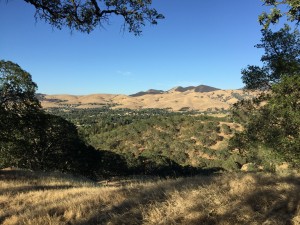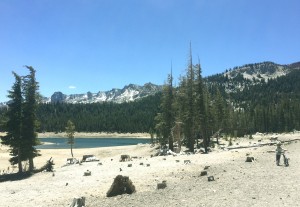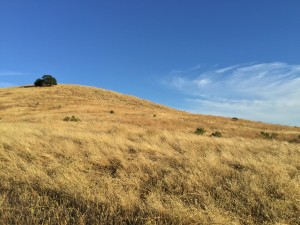20 August 2015

Dry grassland and oak landscape of the Coastal Mountain Range in central California, among the parts of California most heavily impacted by the current drought, taken in August 2015.
Credit: Dominick McPeake
WASHINGTON, D.C. – Global warming has made the California drought worse, according to a new study accepted for publication in Geophysical Research Letters, a journal of the American Geophysical Union.
The latest findings add a new wrinkle to – and do not contradict – the idea that the record-breaking drought is a result of natural variations. The wrinkle is that in the absence of rising temperatures that dry up soils and plants, the current drought would be approximately 15 to 20 percent less severe. Within a few decades the water losses from rising temperatures will create a new arid ‘normal’ for California, according to the new study.
Because warmer temperatures drive water from the ground into the sky, temperature is an important part of the drought equation, according to A. Park Williams, a bioclimatologist at Columbia University’s Lamont-Doherty Earth Observatory in New York and lead author of the new study. It’s not just about how much water falls, but also how much evaporates, he said.

Abnormally low lake level at Horseshoe Lake in the high-elevation Mammoth Lakes Basin in the Sierra Nevada Mountains, taken in June 2015.
Credit: Jennifer Bernstein
“A lot of people think that the amount of rain that falls out of the sky is the only thing that matters,” Williams said. “But warming changes the baseline amount of water that’s available to us because it sends water back into the sky.”
The researchers looked at precipitation, temperature, humidity, wind and other factors in multiple sets of month-to-month climate records from 1901 to 2014. Over those 11 decades they found no trend in long-term rainfall. On the other hand, average temperatures have risen about 1.4 degrees Celsius (2.5 degrees Fahrenheit) over the 114-year period. So when the drought began in 2012, the dry air began pulling what little moisture there was from the landscape, according to the new study.
Because the data used in the study was very complex, the researchers came up with a range for the amount that temperature is contributing to the current drought. They report that the range is 8 to 27 percent. The most likely amount is in the middle of that range, from 15 to 20 percent, said Williams.

Dry grassland and oak landscape of the Coastal Mountain Range in central California, among the parts of California most heavily impacted by the current drought, taken in August 2015.
Credit: Dominick McPeake
The long-term warming/drying trend for the state would be more than enough to cancel out any increases in rainfall that have been projected to come from global warming, according to the study’s authors. According to climate models, by the 2060s, California will essentially be in a state of semi-permanent drought, broken only by occasional very intense, short rainfall events.
That also applies to the potential El Niño moisture which many forecasters are hoping will reach California this winter. The rain could fool people into believing that the drought is over, said Williams. But in coming years the rainfall will be fighting the increased warmth, and people will have to adjust to a new normal, he added.
###
The American Geophysical Union is dedicated to advancing the Earth and space sciences for the benefit of humanity through its scholarly publications, conferences, and outreach programs. AGU is a not-for-profit, professional, scientific organization representing more than 60,000 members in 139 countries. Join the conversation on Facebook, Twitter, YouTube, and our other social media channels.
Notes for Journalists
Journalists and public information officers (PIOs) of educational and scientific institutions who have registered with AGU can download a PDF copy of the article by clicking on this link: http://onlinelibrary.wiley.com/doi/10.1002/2015GL064924/full
Or, you may order a copy of the final paper by emailing your request to Leigh Cooper at [email protected].
Please provide your name, the name of your publication, and your phone number.
Neither the papers nor this press release is under embargo.
“Contribution of anthropogenic warming to California drought during 2012-2014”
Authors:
A.P. Williams: Lamont-Doherty Earth Observatory, Columbia University, Palisades, New York, USA;
R. Seager: Lamont-Doherty Earth Observatory, Columbia University, Palisades, New York, USA;
J.T. Abatzoglou: Department of Geography, University of Idaho, Moscow, Idaho, USA;
B.I. Cook: Lamont-Doherty Earth Observatory, Columbia University, Palisades, New York, USA; and NASA Goddard Institute for Space Studies, New York, New York, USA;
J.E. Smerdon: Lamont-Doherty Earth Observatory, Columbia University, Palisades, New York, USA;
E.R. Cook: Lamont-Doherty Earth Observatory, Columbia University, Palisades, New York, USA.
Contact Information for the Authors:
A. Park Williams: +1 (845) 365-8193, [email protected]
Richard Seager: +1 (845) 365-8743, [email protected]
John Abatzoglou: +1 (208) 885-6239, [email protected]
Benjamin Cook: +1 (845) 365-8395, [email protected]
Jason Smerdon: +1 (845) 365-8493, [email protected]
Leigh Cooper
+1 (202) 777-7324
[email protected]